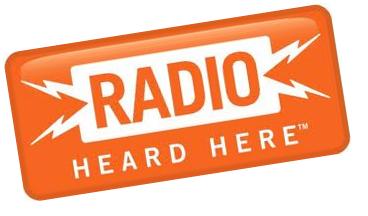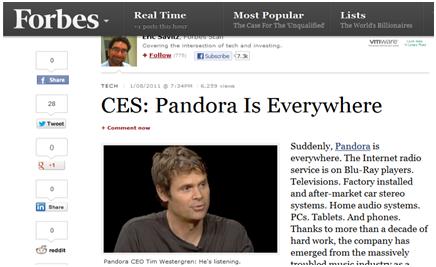The strategies of “radio” pure plays aren’t a mystery. In fact, the CEOs of the biggest streaming brands are telling us exactly what moves they intend to make as they march the ball down the media field.
Radio either responds to the challenge, or it faces an inevitable world where new competitors have better presence than these up-and-comers. That may sound hard to believe, but it is beginning to become a reality, thanks to the aggressiveness of companies like Pandora and the myopia of radio broadcasters.
A case in point is the “everywhere strategy.”
 In fact, it’s been at the heart of broadcast radio’s blueprint for several years now. The idea is simple. “Radio heard here.” Yes, we’re everywhere.
In fact, it’s been at the heart of broadcast radio’s blueprint for several years now. The idea is simple. “Radio heard here.” Yes, we’re everywhere.
Radio bandies about the 94% penetration figure, and points to destinations like mobile apps and 7,000 streams as proof positive that it is ubiquitous.
Well, that’s the competition’s plan, too, and the difference is that they’re not sitting around questioning the value of new or emerging listening locations.
Instead they’re staking them out, and doing everything they can to be wherever consumers want them to be.
Our new Techsurvey8 shows that nearly four in ten of radio’s core listeners listen to streaming radio on a weekly basis or more often. Shouldn’t that get the attention of every honcho, chieftain, and maven in radio?
This Forbes headline from 2011’s CES says it all about Pandora. It’s been their strategy from Day One – and the first paragraph in the article lists out the numerous touch points that Pandora has identified as key avenues of distribution.
I can tell you as someone who moderates a lot of focus groups and L.A.B. sessions, consumers are enjoying these times immensely. Many are pigging out on all the sources, options, and channels they have in front of them. If their desired content is there, great. If not, they’ll go elsewhere.
 For some reason, dotcom CEOs understand that we’re in the Wild Wild West of experimentation and hacking our way to a new future. Not every stab, attempt, or initiative is going to be successful. But because none of us know where all this is going, there’s a certain logic in covering the bases.
For some reason, dotcom CEOs understand that we’re in the Wild Wild West of experimentation and hacking our way to a new future. Not every stab, attempt, or initiative is going to be successful. But because none of us know where all this is going, there’s a certain logic in covering the bases.
Spotify’s recent announcement of a new mobile app for their streaming music platform is another case in point. Their VP of product, Charlie Hellman notes that traditional radio listeners are a significant part of their target audience: “We found those that use radio are really some of the most highly engaged users of Spotify. They stay longer and are more likely to upgrade.”
Right now, it’s a fight for real estate in the streaming world. Consumers want to be assured their desired outlets are going to be around. So do the automakers. At Convergence a few weeks back, Toyota’s John Bucci expressed that concern – another reason why they’re placing their bets on brands that have the best chance of displaying staying power.
At CES this past January, Ford’s Jim Buczkowski, Ford’s Director of Global Electrical and Electronics Systems Engineering, talked with us about the future of the dashboard. Like many influential designers and strategists in the auto industry, he sees the future in mobile streams and local content. Below is clip from our interview:
>EMAIL RECIPIENTS: CLICK HERE TO WATCH JIM BUCZKOWSKI INTERVIEW<
Despite this, we continue to have this conversation in radio about the ROI of streaming – to the industry’s detriment. There are some activities that inherently generate revenue while contributing to the brand. There are other endeavors and investments that simply aren’t going to make money – at least in the near term. Not every strategy and tactic pays off in dollars, whether it is community and charitable events, supporting local schools, sponsoring a neighborhood softball team, or lending a hand when a natural disaster strikes your area. Or streaming, building a Facebook page, setting up a texting platform, or building a mobile app. But if radio is going to continue to promote “everywhere,” the cost of playing is getting higher.
In our new media world, every time there’s an article about how another radio owner or operator isn’t going to stream, is ridding itself of more local talent, or cutting back on investment in content, I have to believe that financial analysts, investors, and yes, broadcast radio’s competition just shakes its head.
Or in the case of Tim Westergren, flashes that million dollar smile.
- What To Do If Your Radio Station Goes Through A Midlife Crisis - April 25, 2025
- A 2020 Lesson?It Could All Be Gone In A Flash - April 24, 2025
- How AI Can Give Radio Personalities More…PERSONALITY - April 23, 2025





Yes, and now my son turns me on to yet another creative, fun, intuitive music source. Songza. Check it out. It builds playlists for any variety of moods. Click on your mood at the time and they treat you to a selection of songs that match the mood. With familiar songs, and surprises. Isn’t that what radio used to do. So you go to Songza on your mobile device. It tells you “It’s Wednesday morning. Play music for: Waking up, Working out, Feeling confident, Singing in the shower, Reading the paper, or Popular genres. Click again and you can zero in on your general music taste…click and let it treat you to some audio adventure. Genius. When the world is offering this kind of option, I am sorry to say: Broadcast radio’s days are numbered. The only unique advantage broadcast radio has is that they can be the heartbeat of their individual communities, much more than another music source….and stations are abandoning that position daily.
Ric, thanks for the note about yet another competitor in the personalized music space. I share your frustration, but believe that radio’s unique advantage – being the heartbeat of local communities – may be more powerful than you – and many broadcasters – think. People may enjoy global resources, but they live in local cities and towns. Media outlets that reflects those values, issues, and vibes may have a distinct edge over Interent pure-plays if they play their cards right. Thanks for taking the time to comment.
Here’s a thought. Why doesn’t radio create compelling, must-listen-to-products? THEN, make them available on the variety of platforms people want to use. There is so much wag-the-dog here. Everyone chases digital dollars and mobile dollars and other dollars while ignoring the core concept of what makes radio work – getting gobs and gobs of listeners. Working for an ad agency, we use radio effectively. And guess what – it actually works as an advertising medium. But their digital products? Worthless. If digital advertising was as effective as some say (and it isn’t) then I can get more eyeballs from cheaper services than what a radio station is going to charge me for a leader board ad. Radio needs to remember that it is in show bidnis. Entertain us…and by entertain us I do not mean play a safe list of tested songs interrupted by self-promotional announcements. The reason platforms like Facebook and Twitter are so strong is that they create an emotional bond. People are invested in them and get great entertainment ROI. Radio, instead, plays defense and tries to adapt and morph where they see new threats. The question is, fred, since so many people like you see this and tout this – why does it not change?
Steve, thanks for the comments…and the passion. I believe that the devil is in the details – that is, you have to understand digital platforms from mobile to social before you can create content and sales packages that work. Just as radio is not “TV without pictures,” success in digital requires a studied approach to new outlets, research, and an open, curious mindset. Too often, we are making “meatball sundaes.” Thanks for taking the time to weigh in.